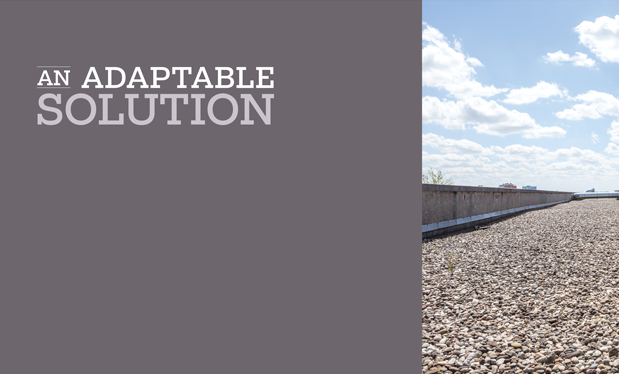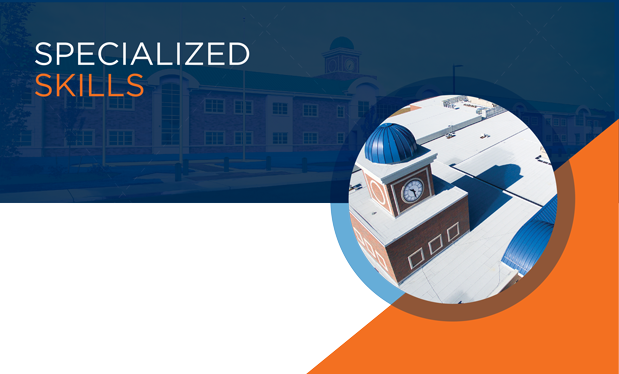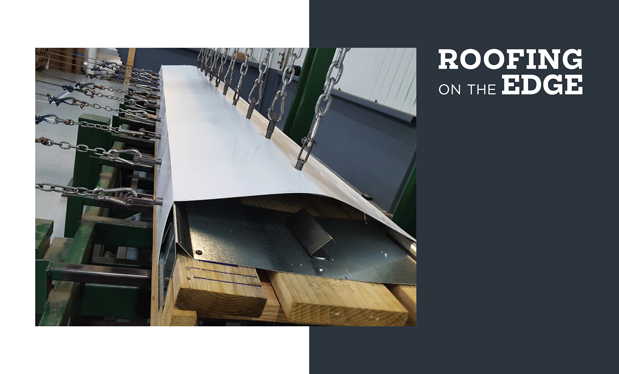Function often supersedes aesthetic appeal when it comes to roof systems for commercial facilities. And for residential structures, many homeowners default to traditional asphalt shingles, believing them to be more practical and cost-effective than other roof coverings. But this isn't always the case. For example, metal roof systems are price-competitive, and the benefits a metal roof can provide are worth considering—especially given that demand originates almost equally from commercial and residential markets alike.
Metal roofing's expansion in commercial and residential markets, as well as increasing acceptance of metal roofing among property owners, has driven industry growth during the past 15 years, with significant growth further projected for the next three years, according to Principia Consulting, Malvern, Pa. Myths surrounding the value of metal roofing still exist, but it is time the truth is shared.
Metal roof advantages
Metal roof systems can reflect a large percentage of sunlight and quickly emit absorbed heat. According to the Metal Construction Organization, metal roof systems can last longer than most nonmetal roofing products and endure extreme weather conditions. Metal roof systems also add sustainability features. They can accommodate solar panels without requiring penetrations that may compromise roof integrity, and they contain recycled content. When finished with a proper coating system, 'cool' metal roof systems can help further reduce a building's carbon footprint, energy consumption, and cooling and heating loads.
Metal roof systems also can mitigate the urban heat island effect. The Department of Energy states that by reducing energy use, cool roof coatings on metal roof systems can reduce air temperatures inside buildings and decrease the production of associated air pollution and greenhouse gas emissions to help improve human health and comfort.
Durability
Properly installed, a metal roof system should last as long as the structure on which it is installed and requires minimal maintenance. According to the 2018 Metal Roofing Pros & Cons: Facts, Myths—Metal Roofing Buying Guide published by www.metalroofing.systems, aluminum or steel shingles can last 50 years or more; copper and zinc roofs often can last more than 100 years. This means a typical metal roof system will last about three to seven times longer than the average asphalt shingle roof system, which usually needs to be replaced every 12-17 years.
Sustainability
Metal is a sustainable and durable alternative to asphalt or cedar. At least 30 percent of the material used to create a metal roof is recycled, and some metal roofs are made of 100 percent recycled content. This, coupled with durability and long lifespan, makes metal an environmentally friendly roofing option.
Style and aesthetics
Metal roof panels are available in more colors and designs than many other roofing materials and come in several shapes and sizes. Metal roof systems can be embossed and made to look like asphalt, granite, tile and much more. Additionally, metal panel coatings come in any color or print desired and provide enhanced performance characteristics.
Strength and weather resistance
Metal roof systems can withstand the elements for far longer than an asphalt roof system. In fact, they can withstand 140-mph hurricane-force winds and hail, and they resist fire, mildew, insects and rot. In contrast, shingles can be damaged by winds with speeds of 70+ miles per hour. Shingles can even be blown off a roof, especially if they have been poorly fitted.
Metal roof systems are also impervious to rain and snow because of the way the panels interlock and their hard, slippery surfaces.
Energy-efficiency
Metal is one of the most energy-efficient roofing materials available and can save homes up to 40 percent in air-conditioning costs, according to the Metal Roofing Alliance. In regions with hot climates, a light-colored metal roof can reasonably be 50 to 60 degrees cooler than a dark asphalt shingle roof system. Cool roof coatings can also lower peak electricity demand to help prevent power outages, and they can reduce power plant emissions. Plus, they provide excellent insulation during the winter.
Cost
One of the greatest myths surrounding metal roof systems involves cost. A California study conducted in 2008 by the U.S. Environmental Protection Agency found cool roofs provide an average yearly net savings of almost 50 cents per square foot. In truth, metal roof systems can save more money over time than black roofs. As less heat enters a building through a roof, it reduces the need for and cost of building cooling systems.
Heat conduction
By reflecting a large percentage of sunlight and quickly emitting any absorbed heat, metal roof systems with cool coatings save energy needed for air conditioning during the day. Although metal is low in insulation R-value, metal roofing can be applied over rigid-foam insulation that has high R-values.
Weight
Metal roofing materials generally are 50 percent lighter than asphalt roofing materials and 75 percent lighter than concrete tile, fiber cement shakes and slate. Compared with the weight of tile at 750 pounds per square or concrete tile at 900 pounds per square, metal roofing is lightweight. The weight of most metal roofs run from 50 to 150 pounds per square.
Metal drawbacks
Despite all the advantages, there is one important disadvantage when choosing a metal roof system: the initial cost investment. Many people are put off by the idea of buying a metal roof because it will be more expensive than cheaper options such as asphalt. And this makes sense if you are buying a roof for a building in which you only have a short-term interest.
However, if you have long-term interest in a home or property, it may be worth comparing the cost of a metal roof system to the combined costs of asphalt roof system repairs and replacements.
If the investment is an issue, it may be worth considering cheaper corrugated steel roofing. Corrugated metal roofs are usually priced similarly to asphalt shingles but can be expected to last about twice as long.
Corrugated steel will require some maintenance; every decade or so the fasteners will need to be retightened, and the roof will need to be resealed. Still, corrugated steel roofs can offer excellent value and can be painted or coated in a variety of colors.
Metal coatings
Advances in high-performance exterior metal coating options have made buildings look better for a longer time. Exterior metal coatings enhance a metal roof system's aesthetic and performance abilities, specifically offering a waterproof barrier that stands up to humidity, acid rain and corrosive salt. In addition, color selection is nearly infinite, and products are formulated to meet sustainability demands.
Coating manufacturers are developing formulations to resist etching, marring and erosion rates to extend a building's aesthetic lifespan. To ensure uniform gloss, color and thickness, a coil-coat process is the preferred application method for metal roof systems. Using this method, rolls of metal are painted before being shaped into each individual panel. The pre-painted sheets of steel or aluminum can then be cut, slit-formed, corrugated, profiled and molded into shingles, shakes, curves and various shapes for distinctive architectural designs.
When selecting an exterior architectural metal coating for a metal roof system, it is important to know how the coating will stand up to the elements. A reputable coatings manufacturer will offer warranties on all its products, as well as Construction Specifications Institute's three-part format specifications to ensure optimal performance. Coating manufacturers' specifications will reference ASTM International test protocols for evaluating qualities such as specular gloss, color consistency, adhesion, film hardness and thickness, flexibility, water resistance, abrasion resistance, chemical resistance, salt spray and corrosion resistance, as well as chalking.
American Architectural Manufacturers Association (AAMA) standards are considered the most stringent for coatings applied to aluminum extrusions, panels and substrates; AAMA also publishes standards for hot-dip galvanized and zinc-aluminum-coated steel substrates. Energy-efficient coatings may be ranked by ENERGY STAR, LEED® and Cool Roof Rating Council® performance standards.
In addition to test protocols and coating manufacturers' specifications, selection and installation guidelines are available from industry associations, government agencies and various metal roofing manufacturers to inform decision-makers about their coating selections and performance expectations. Most manufacturers also specify in their literature whether they meet building codes in specific regions.
The primary environmental concern with liquid coil coatings is the solvents used. Some of these solvents are considered volatile organic compounds (VOCs), which have been associated with environmental ozone depletion. When coil coatings are applied by responsible finishing facilities, VOCs can be safely captured and incinerated before the painted material leaves the factory. And, in some cases, the heat from incineration is then reused to heat different parts of the coating process.
The coating selection for metal roof systems also can have positive environmental advantages.
Seeing the opportunity for innovation, cool metal roof coatings have come to the forefront of commercial building design and are now the most effective energy-saving finish for metal roof systems.
The metal option
Achieving the desired benefits and intended performance of cool metal roof systems requires thoughtful specification, careful selection of raw material suppliers and close collaboration with experienced coatings manufacturers. Through this collaboration, roofing industry professionals can meet both the building team's expectations and their ideals of contributing to a better urban environment.
For articles related to this topic, see:
"Metal ahead," October 2015 issue
"A residential market option," May 2015 issue



